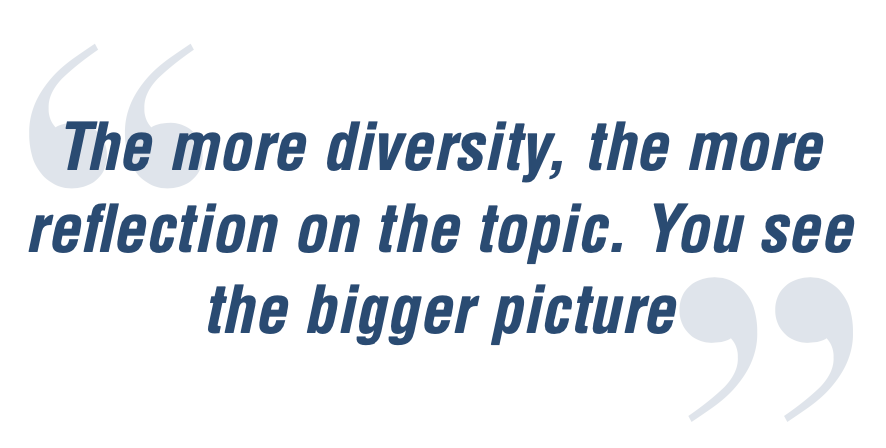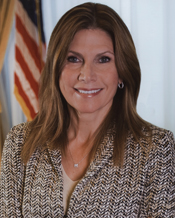Getting on Board with Diversity: Behind the Push for More Gender Representation
States and institutions are enacting mandates requiring greater inclusion of women and underrepresented groups on corporate boards; what are the key questions for pharma?

DeeDee DeMan was biding her time to make a presentation before a particular board of directors one year. The board chair of this biopharma Fortune 500 company had invited her to appear before the directors and explain how her niche executive search firm, Bench International, would counsel the board on how to find qualified C-suite executives—but who were female.
But first, she had to wait while the board, comprised of predominantly men, finished their cocktail hour.
“I was wearing my traditional black,” recalls DeMan, “and two board members—one male, one female— came up to me and gave me drink orders.”
For the record: one vodka gimlet, one Chivas on the rocks.
The chairman was standing not too far away, and had heard what his board members had requested. “He was smiling,” she says.
When the meeting began, DeMan walked in, drinks in tow. She put them in front of their owners. Her only comment to them? “I am glad you didn’t ask me to cook, because I haven’t done that in years.”
They didn’t laugh.
DeMan made her pitch. “I was successful,” she says.
The frustration she felt had been felt many times before. Her niche business specializes in finding underrepresented, qualified people for executive and board positions. “I can’t tell you how many times I would be waiting to present my deal, and would see men coming out from the boardroom, and then I would enter as a presenter,” DeMan remembers. The body language would change immediately, she says.
Since that informative exchange above occurred, women have gained access to the corporate inner sanctum in large numbers, relatively speaking. The reasons aren’t so much evidence-based, as peer-reviewed work goes back years regarding a link between gender diversity and financial, environmental, ethical and other outcomes when women are admitted to the boardroom.1,2 No, it is the diversity mandates, whether passed by state legislatures or in requirements from major financial, investment and lending institutions, that are forcing the diversity issue. Currently, women fill 23% of all board seats of the publicly traded companies in the Russell 3000 index, which includes virtually all firms.3
And more women will follow, as more institutions, like the Nasdaq, ultimately decree how boards will literally look in the next few years. Says DeMan: “The biggest driver is the regulatory environment. Before, it was the right thing to do.”
The questions are many and closely linked. Who will fill these spots? How and where will these women learn what is required, and what it takes, to be a successful board member?
And an overarching question: What is it about including women as board members, if anything, that seems to increase profits, has prodded male board members to temper their overconfidence, and convinced their board peers that a product recall, even a Class III recall, is nothing to monkey around with?
Source: bas121 - stock.adobe.com

Who’s mandating
The following is an abstract to a 2004 article in the journal Corporate Governance about women and corporate boards.1
Using evidence from a survey of women directors in FTSE 100 companies, this paper considers possible explanations for the persistent homogeneity of top UK boards ... Explanations usually include women’s lack of ambition, lack of experience, and lack of commitment. These have been disproved by research, but underlying theories of social exclusion may provide insight into this persistent phenomenon.
The Norwegians apparently wouldn’t have agreed with this assessment, because in 2003, its government said that by 2006, state-owned firms had to have women comprise 40% of state boards, and by 2008, all publicly traded firms.4 If a company didn’t comply, it had to move its corporate headquarters elsewhere. By 2009, all corporate entities were on board.
Many countries, including Kenya, Israel, and Italy, among others, passed mandatory diversity legislation by 2011; most included penalties for not doing so.4
In the US, California at first tried a resolution to push corporations into including women, but it didn’t work. Between 2013 and 2016, just 20% of companies with headquarters in the state put the requested number at one to three women on their boards.5
But California was serious about diversity. The blah response to the resolution prompted the state legislature to impose mandates, with financial consequences. By the end of 2021, all public companies have to include one member from an underrepresented group.
Other states, like Colorado, Pennsylvania, and Ohio are also trying the resolution route; several others, including Hawaii, Massachusetts, Michigan, Ohio, and New Jersey are looking at mandating diversity; each bill, like California’s, includes monetary penalties for noncompliance.6
Major institutions, such as BlackRock, Slate, and Nasdaq are helping drive the diversity bus. At Nasdaq, its request before the US Securities and Exchange Commission (SEC) is expected sometime this summer. The Nasdaq wants at least two people on a board that come from underrepresented populations, depending on the board’s actual size.7
The consulting firm Deloitte, in its sixth report on gender diversity in the boardroom, found that out of 8,658 companies worldwide, only 5.3% of them had a female chair. Norway had the most, at 41%. The US had 17.6%.8
Why women?
A 2019 study that reviewed data on 1,629 companies, their CEOs, and their boards, found that boards with 10.4% or so female members tempered major board decisions such as acquisitions.9 During the Great Recession, boards without women performed worse on company value, return on equity, and return on assets, according to the study. Overconfidence, wrote the authors, can lead CEOs to underestimate risk, while women can help in crises.
“Women think more collaboratively,” says Sylvie Grégoire, PharmD, a member of Novo Nordisk’s board of directors for six years. “They put themselves in the shoes of the messenger.” Discussing an issue creates a better atmosphere for reflecting and strategizing, she adds.

Corinne Post, PhD, who will join the Villanova School of Business in the fall as the Fred J. Springer Endowed Chair in Business Leadership, says in the field of gender studies, women have been found to be more risk adverse, but they also are more creative. The more diversity, the more reflection on the topic. “It slows down the decision-making process; you see the bigger picture,” she says.
Last year, Post, currently chair, department of management, Lehigh University, participated in a study involving 92 publicly traded companies and their 4,271 product recalls that occurred between 2002 and 2013.10 Boards with more than one woman director recalled medical supply products 28 days faster than those that did not. With regard to those products that did not involve injury, but an FDA infraction, boards including women recalled more of them than did all-male boards.
Lead author Kaitlin Wowak, PhD, assistant professor of IT, analytics, and operations in Notre Dame’s Mendoza College of Business, said in interviews with company executives, they described the differences in questions asked in a product recall. Women want to know how patients are affected; the men want to know “who is to blame and how much it will cost.”

Post said if we assume women are those who will look out for customers and their safety, it relieves men unduly of that responsibility, and it is not a good thing to relieve either gender of responsibility for safety, patients, etc.
Grégoire says men and women, in terms of their contributions to a board, are based on their professional experience. “But I bring it with my own view of the world, and my own personality,” she says. “Women have a different view of the world, the way they approach and think about things; it is slightly different than men.”
Grégoire serves on three committees for the Novo Nordisk board. She also is the executive chair of the board of EIP Pharma Inc. and is a director with PerkinElmer, an instrumentation and testing company.
“In our culture, men are shaped to measure themselves and their peers in primarily competitive terms,” wrote Leonard Glass, MD, an associate clinical professor of psychiatry, Harvard Medical School. “Until fairly recently, women have been rewarded primarily for their capacities to attract, sustain, and nurture loving attachments through empathic connection and collaboration. A vast generalization to be sure, but one that is broadly acknowledged.”

Bob Jansen, founder and CEO of Zensights, believes that a board that all looks the same from a physical and experiential perspective, is much more prone to “Group Think”, which ultimately can hurt an organization’s performance. Diverse boards blend each Board members differentiated personal and professional experiences to analyze challenges and opportunities in many different ways–ensuring well thought out actions moving forward.
However, women are up against an established male-dominated network, he believes. “The good old boy network is real,” says Jansen.
Mary Bono Mack, the former California congresswoman who served on numerous caucuses and subcommittees while serving from 1998 to 2013, also commented that linear thinking isn’t specific to genetics; it is more cultural. She now chairs the Community Anti-Drug Coalitions of America (CADCA).

“I think people are trained not to accept [creativity as a] gift,” she says. “It’s like forcing a left-handed child to become right-handed.”
Grégoire explains why women would be interested in a board position. Boards are a natural progression of executive management, she says. “If you have done quite a few executive roles, then you have the experience to help another company to grow, and that is what is attractive—you are a custodian for the shareholders.”
But first, notes Michael Injaychock, executive director, data and analytics, brand operations, cell therapy, Bristol Myers Squibb, women need to be hired for executive positions. Women may win awards for employee of the month and similar accolades, but senior management doesn’t respect a plaque, Injaychock asserts.
“Companies respect you through promotion, titles, and money,” he says. “This is where I am seeing industry make that shift; they are moving from the point of recognition to respecting diversity into that C-level position.”
The prescient, the planners, and the diversity practitioners
For at least 10 years, a few people connected to the biopharma and big pharma spaces have been, as DeMan puts it, rolling the diversity rock up the hill.
Zensights, whose primary raison d’etre is advising pharma companies on choosing suppliers and vendors, runs a series of leadership meetings, which it launched nine years ago. Inclusion was always something attendees discussed, says Jansen, “but the board piece came front and center three years ago,” with California’s mandatory inclusion requirement.
Zensights hosts a three-part series for pharmaceutical leaders called “Demystifying the Board Experience.” The series’ themes are how a board functions; a year in the life of a board member; and how a board looks at financials.
Bench International has assembled what it calls a “Bank of Women”—550 women and growing who are board- and C-suite-trained. The Bench program provides coaching and mentoring to women interested in moving to the top rungs.
DeMan notes other programs include board governance initiatives offered by some universities, the Athena Alliance, and Women In Bio. For those with no senior management experience, these programs offer instruction into how a board operates. And they usually provide mentors, she says.

To be successful, the women interviewed for this article agree that it is necessary to learn how to navigate a board’s culture. It is the fit that matters most; it’s more complementary as opposed to matching up specialty to specialty. Grégoire says, “The job of the board helps management think strategically and push them into other ways of thinking. They want people who bring experience from other angles.”
But first, you have to grow candidates. In 2017, Injaychock had two qualified candidates to fill a position on his analytics team at BMS. Injaychock decided he didn’t want the experienced beta scientist with little imagination; he wanted to hire a woman two years of out college. She had a different perspective on the position, had command of modern technology, and other skills. “The managing directors were skeptical,” he remembers; but as the hiring manager, “I stood by her.” The young woman is now an associate director.
A leader, Injaychock says, has to be willing to see beyond what is in front of him or her. “This is where the debate happens, when you are making that decision to hire someone who is different,” he notes.
Pushback
It remains to be seen what the 600 or so affected companies in California will ultimately do, as only half have met a requirement to report to the state about their board’s makeup, as of last March. Of the around 300 that did file, 37 reported having no women on their boards—which violated the legislature’s requirement to have one woman onboard by December 2019.6
Republicans in the Senate aren’t happy with the Nasdaq’s request, telling The Wall Street Journal that such a regulation would interfere “with board members’ duty to govern in the best interests of shareholders and could harm financial performance.”11
And a number of academics, from Wharton, Morehouse College, and Harvard, are warning against flat-out connecting improved company performance with diversity. The gains are more nuanced—more innovation, more teamwork, more creativity. The balance sheets, said Wharton professor Katherine Klein in a podcast, do not show change with women members in meta-analyses of rigorous studies. Gender, be it male or female, “has zero impact.”

Injaychock begs to differ. In 2012, the executive was sent to Japan to lead marketing operations by his then company. The year before, marketing operations had missed its numbers, which is “why they brought in the ex-pats,” says Injaychock.
He had 30 people in his division. “I was shocked to see how few women were in management.” Injaychock’s first hire for a management position was a Japanese woman. And then other women came to see him. “’I want to join your group,’” he recalls them saying. Injaychock eventually put together a nearly all-female, all-bilingual management group. Members were from Honduras, Japan, Canada, and the U.S.
“We hit overall sales targets three years in a row. We crushed it,” he says.
The advice
Among the pieces of advice offered by the experts around diversity is to join the compensation committee, says DeMan. Doing so could help achieve equity for all, top down, bottom up. She also advises to read everything there is about the board, and what is expected.
Grégoire knows what it’s like to be the only woman in a men’s club, both in senior management and on boards. Expect that it could be awkward when socializing or traveling, she notes. Male conversation on male-centric topics can leave a woman feeling as if she is not an equal partner, says Grégoire.
She also advises that women—who will be in high demand due to pending and existing mandates—join boards where they feel they can be successful. Don’t throw yourself into a demanding position right off the bat, she says. Take your time and figure your motivation for joining a board. Board directors—those who are devoted—find that the work levels can be demanding.
To do a good job, a board director needs to devote at least 20 to 25 hours a month to the role, Grégoire believes. Serving on one committee often requires that many hours. And then there are the ad hoc meetings and the reports that need to be read, let alone following the company and its competitors.
Bono Mack stresses to avoid second-guessing decisions, and don’t be afraid to ask questions; don’t spend time thinking whether the question was necessary. She advises to trust yourself more.Board members do not function as staff—and good ones do not micromanage, Bono Mack continues. Learn everything you can about the company, she emphasizes.
“You need to realize you are a piece of the board, and the pieces put together make it great.”
References
- Val Singh,Susan Vinnicombe. Why So Few Women Directors in Top UK Boardrooms? Evidence and Theoretical Explanations. Corporate Governance. Oct. 15, 2004.
- Ferdinand A Gul, Bin Srinidhi, Anthony C Ng. Does board gender diversity improve the informativeness of stock prices? J Accounting and Economics. April 2011, 51(3): 314-388.
- Erin Lehr. Q3 2020 Gender Diversity Index. Equilar. Nov. 20, 2020. https://www.equilar.com/reports/76-q3-2020-equilar-gender-diversity-index.html
- Siri Terjesen, Ruth V. Aguilera,Ruth Lorenz. Legislating a Woman’s Seat on the Board: Institutional Factors. Driving Gender Quotas for Boards of Directors. Journal of Business Ethics. February 2017.
- Wharton University of Pennsylvania. What’s the Impact of More Diverse Corporate Boards? Oct 16, 2018, podcast. https://knowledge.wharton.upenn.edu/article/california-board-gender-quota/
- Michael Hatcher, Weldon Latham, Jackson Lewis P.C. States are Leading the Charge to Corporate Boards: Diversify! Tuesday, May 12, 2020. https://corpgov.law.harvard.edu/2020/05/12/states-are-leading-the-charge-to-corporate-boards-diversify/
- Alexander Osipovich. Ruling on Nasdaq Diversity Plan for Boards Is Delayed by SEC. The Wall Street Journal. March 10, 2021.
- 8. Deloitte. Women in the boardroom.A Global perspective - sixth edition. https://tinyurl.com/2h95kynz
- Jie Chen, Woon Sau Leung, Wei Song Marc Goergen. Why female board representation matters: The role of female directors in reducing male CEO overconfidence Journal of Empirical Finance. Sept.2019, 53: 70-90.
- Kaitlin D. Wowak, George P. Ball, Corinne Post, David J. Ketchen Jr. The Influence of Female Directors on Product Recall Decisions. Manufacturing & Service Operations Management. March 26, 2020. https://doi.org/10.1287/msom.2019.0841
- Andrew Ackerman. Nasdaq’s Plan for Diversity on Corporate Boards Is Decried by Senate Republicans. The Wall Street Journal. Feb. 12, 2021.
Christine Bahls is a freelance writer and researcher based in Pennsylvania
